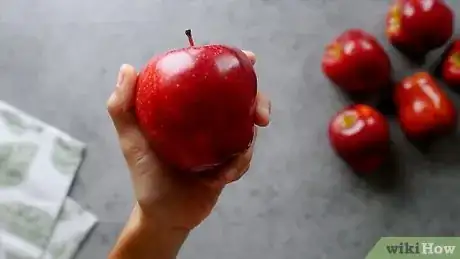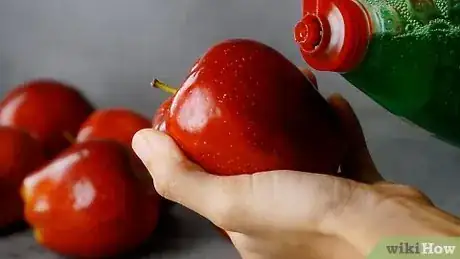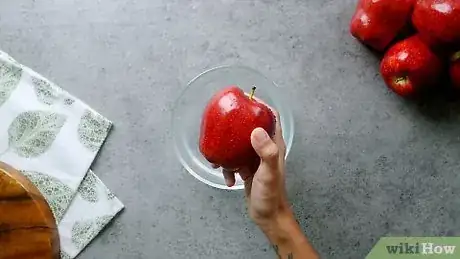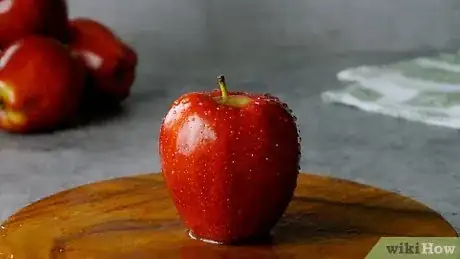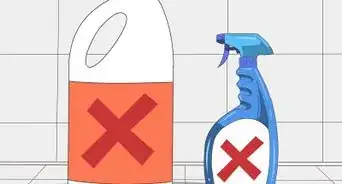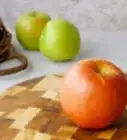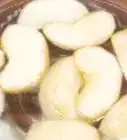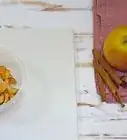This article was co-authored by Jennifer Levasseur. Chef Jennifer Levasseur is a Personal Chef and the Owner of The Happy Cuisiniere based in Breckenridge, Colorado. She has over 12 years of culinary experience and specializes in Mountain and Contemporary Rustic cuisine. Moreover, she can craft dishes and modify menus to accommodate dietary restrictions, such as gluten-free, vegetarian, vegan, pescatarian, and dairy-free diets. In addition to a Bachelor’s degree in Marketing and Management from the University of Houston, Chef Jennifer holds Associate’s degrees in Culinary Arts and Baking & Pastry Arts from Houston Community College.
This article has been viewed 87,549 times.
You should always clean fruit, including apples, before eating it. This removes harmful pesticides and bacteria. Usually, apples can be cleaned using only tap water. Very dirty apples, however, can be cleaned with vinegar. Always wash your hands before cleaning apples. Remember that even organic fruit can harbor bacteria and should be cleaned.
Steps
Washing a Store Bought Apple
-
1Check the apple first. Before washing an apple, examine it quickly. Look out for any mold, bruises, or other damage. If you notice any bruises or mold, cut them off with a knife before washing an apple.[1]
- If purchasing apples at the store, opt for undamaged apples.
-
2Wash your hands. When washing an apple, it's important to do so with clean hands. Wash your hands under running water using antibacterial soap before washing an apple.[2]
- Dry your hands with a clean cloth or paper towel after washing them.
Advertisement -
3Run the apple under tap water. Tap water is enough to remove unwanted dirt, debris, and bacteria from an apple. Run the apple under water, turning as necessary to clean all sides of the apple. When you're done, dry the apple with a paper towel or clean cloth.[3]
-
4Do not use soap or detergent. It is not necessary to use soap or detergent to wash apples. Residue from soap and detergent can leave you with an upset stomach. Stick to tap water to clean apples.
Sanitizing Very Dirty Apples
-
1Fill a bottle with vinegar and water. With freshly picked apples, you may need more than water to clean them. Apples stained with dirt and debris can be cleaned with vinegar. Fill a bottle with three cups of water and one cup of white vinegar. Shake the bottle to mix the water and vinegar.[4]
- Add a scoop of baking soda for extra cleaning power.
-
2Spritz your fruit. You do not need to soak apples in vinegar. In fact, doing so could erode the apples. Instead of soaking them, spritz down the apples with vinegar. Add just enough to coat the surface of your apple. This usually takes around six spritzes.[5]
-
3Rinse the apples with tap water. Once your apple is coated in vinegar, you can rinse it under tap water. Turn the apple as necessary to rinse all sides of it. The vinegar should remove any layers of dirt or dust on the apple.[6]
- It is not necessary to use anything but your fingers to scrub the apple.
Avoiding Common Mistakes
-
1Avoid fancy washes. It is rarely necessary to soak apples or use ingredients other than tap water or vinegar to wash them. Fancy waters that involve soaking apples can change their taste. Stick to tap water for the most part, and vinegar if your apples are very dirty. Elaborate washes will do little to clean apples.[7]
-
2Wash apples even if they're organic. Many people think organic apples do not need to be washed. While organic apples use fewer pesticides, they are still prone to environmental bacteria and can be contaminated during transport. Even organic apples should be washed under tap prior to eating.[8]
-
3Do not automatically throw out moldy produce. Moldy produce does not have to be discarded if only a small corner is infected with mold. If you see a small part of your apple is moldy, cut away that portion with a knife. Unless an apple is completely covered in a layer of fuzzy mold, there is no need to throw it away.[9]
References
- ↑ http://www.bhg.com/recipes/how-to/cooking-basics/how-to-wash-fruits-and-vegetables/
- ↑ http://www.bhg.com/recipes/how-to/cooking-basics/how-to-wash-fruits-and-vegetables/
- ↑ http://www.bhg.com/recipes/how-to/cooking-basics/how-to-wash-fruits-and-vegetables/
- ↑ http://www.npr.org/templates/story/story.php?storyId=14540742
- ↑ http://www.npr.org/templates/story/story.php?storyId=14540742
- ↑ http://www.npr.org/templates/story/story.php?storyId=14540742
- ↑ http://modernfarmer.com/2015/01/7-myths-washing-produce/
- ↑ http://modernfarmer.com/2015/01/7-myths-washing-produce/
- ↑ http://modernfarmer.com/2015/01/7-myths-washing-produce/
